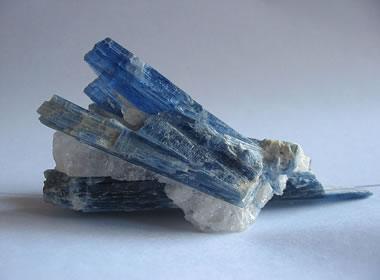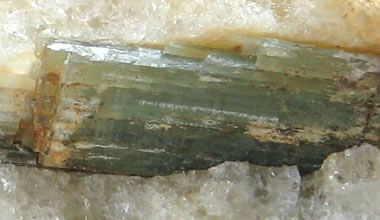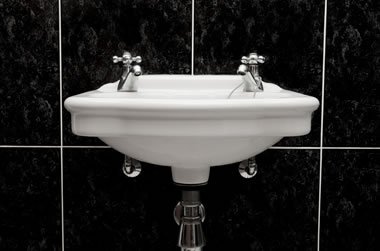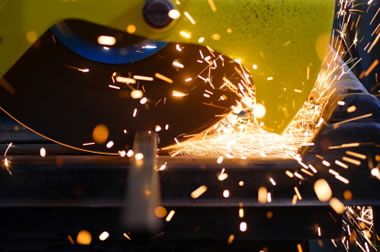المدير العام
المدير العام


عدد المساهمات : 1713
السٌّمعَة : 1
تاريخ التسجيل : 26/08/2011
 | |  Kyanite Mineral Uses & Properties Kyanite Mineral Uses & Properties | |
Kyanite
Mineral Uses & Properties Kyanite is a metamorphic mineral that most often forms from the high
pressure alteration of clay-rich sedimentary rocks. It is found in the
schists and gneisses of regionally metamorphosed areas and less often
in quartzite or eclogite.
Kyanite's typical habit is a bladed crystal although it sometimes
occurs as radiating masses of crystals. Kyanite is often associated
with other metamorphic minerals such as garnet, staurolite and corundum.
Kyanite's Unusual Hardness
Kyanite specimens have a variable hardness. The long crystals have a
hardness of about 4.5 to 5 if tested parallel to the length of a crystal
and a hardness of 6.5 to 7 if tested across the short dimension of a
crystal. The mineral was once commonly called "disthene" which means
"two strengths".
Polymorphs of Al2SiO5
Three minerals have a chemical composition of Al2SiO5
These are kyanite, andalusite, and sillimanite. Kyanite is the high pressure
polymorph, sillimanite forms at high temperature and andalusite is the
low pressure polymorph.
Many Industrial Uses of Kyanite
Kyanite is used to manufacture a wide range of products.
An important use is in the manufacture of refractory
products such as the bricks, mortars and kiln furniture used in
high temperature furnaces. For foundries, the molds that are
used for casting high temperature metals are often made with kyanite.
Kyanite is also in products used in the automotive and railroad industries
where heat resistance is important. Mullite, a form of calcined kyanite,
is used to make brake shoes and clutch facings.
Use in High Refractory Strength Porcelain
Kyanite has properties that make it exceptionally well suited for the
manufacture of a high refractory-strength porcelain - a porcelain that
holds its strength at very high temperatures. A familiar use of
this type of porcelain is the white porcelain
insulator on a spark plug.
Kyanite is also used in some of the more common forms of porcelain, such as
those used to make dentures, sinks and bathroom fixtures.
Use in Abrasive Product
Kyanite's heat resistance and hardness makes it an excellent
material for use in the manufacture of grinding wheels and cutting
wheels. It is not used as the primary abrasive, instead it is
used as part of the binding agent that holds the abrasive particles together in the shape of a wheel.
Expansion of Kyanite When Heated
Kyanite, unlike most other minerals, can expand significantly when heated.
Depending upon particle size, temperatures and heating conditions, kyanite can expand
to up to twice its original volume when heated.
This expansion is predictable. In the manufacture of certain refractory
products, specific amounts of kyanite are added to the raw material (which
shrinks during heating) to maintain volume in the finished product.
Kyanite Use as a Gemstone
Occasionally, clear and colorful kyanite is encountered. This material is highly prized by
those who cut gemstones. It can be cut en cabochon, faceted, or used to produce beads and pendants.
Kyanite is considered to be an "exotic" gemstone because it is not often used in jewelry. Photos of Kyanite Gemstones.
|  |

Kyanite is often cut "en cabochon" or as a faceted gemstone. Kyanite Photos |

A very common habit of kyanite is blue bladed crystals. Kyanite Photos |
 
The porcelain insulator on this spark plug was made with kyanite.
© iStockphoto / Juergen Barry |

Kyanite is used in the porcelain of sanitary fixtures.
© iStockphoto / Carl Kelliher |

Kyanite is used as a heat resistant binding medium in cutting tools and grinding wheels.
© iStockphoto / Ron Sumners |
|
| |
|
